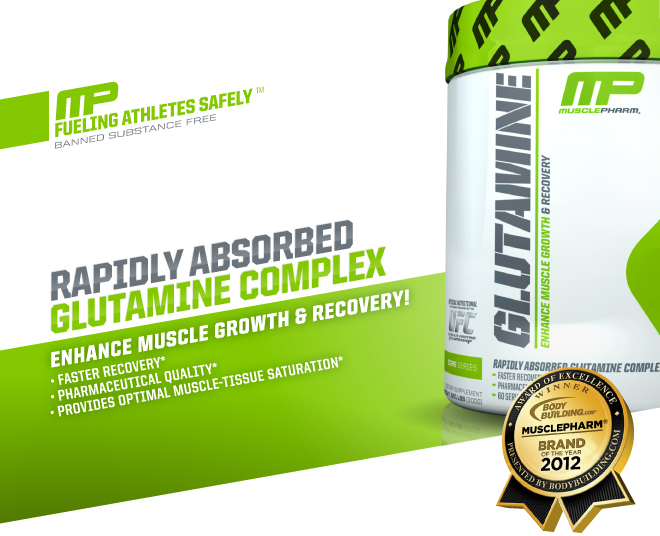Glutamine is the most abundant free amino acid in human muscle. Although not as sexy as creatine or arginine, it still serves several important roles for fitness enthusiasts.
What Glutamine Does
It’s hard to narrow it down to just one function within the body. They include:
- Immune system – utilized as an energy source and source for nucleotide synthesis, especially during increased activity to maintain the immune response
- Glycogen – stimulates glycogen synthase to increase glycogen storage
- Improved gut function – utilized as an energy source for cell proliferation in the gut creating a healthy mucosa
- Volumizing effect – shifts fluid movement due to its osmotic properties, causing faster water absorption in the gut and cell swelling within the muscle
- Growth Hormone – Enhances growth hormone secretion
- Acid/Base buffer – during acidic conditions, utilized by the kidneys for ammoniagenesis
What Can You Expect With Glutamine?
Glutamine’s effects are extremely subtle. You won’t notice an improvement in strength immediately, or see a difference in the mirror right away. You may notice an improvement in your recovery ability, especially if you’re an endurance athlete or on a low carbohydrate diet.
When You Should Take Glutamine
Because you want to keep your glutamine plasma levels elevated throughout the day, it’s best to split up the dosages, up to 4 times daily. For an endurance athlete, it’s best to consume it 45-60 minutes before a race, sip it throughout the race, and consume it in a postworkout shake.
Acute exercise, like a 45 minute strength training session, has actually been shown to increase plasma glutamine levels. Thus, if you solely strength train, it really doesn’t matter when you take it, as long as you split up the dosages. If you’re on a low carbohydrate diet and strength train, taking it in your postworkout shake may help increase glycogen synthesis.
How Much Glutamine You Should Take
It varies. Up to 30 grams daily, in divided doses, have been used without any detrimental effects. The most effective dosing strategy involves evaluating plasma glutamine levels. However, that’s impossible for 99.9% of us. It’s easiest to start with 3 grams, and take it up to 4 times daily. If you’re using it just in your postworkout shake, 8-10 grams of glutamine will be sufficient.
The Downside of Glutamine
Side effects are minimal. With higher does, some experience gastrointestinal upset.
TJ’s Inside Scoop
The evidence supporting most of glutamine’s benefits is sketchy at best. When I take a look at all of the supplements available, glutamine doesn’t make my top 10 EXCEPT during two situations:
- If I’m an endurance athlete that doesn’t consume a ton of protein, and I routinely get sick. My glutamine levels may be low enough that they justify adding glutamine for my immune system.
- If I’m on a severe low carbohydrate diet/high protein diet and my vegetable intake is minimal, glutamine may help buffer the acidic environment. Also, it may help keep my glycogen levels elevated despite my low carbohydrate intake. If I solely strength train, at the very most, I’d use 5-10 grams in my postworkout shake.
What Does Glutamine Stack Best With
In your post-workout shake with creatine and protein, beta alanine, citrulline malate, arginine
Top Products Using Glutamine
Dymatize Micronized Glutamine, Scivation Xtend, Optimum Nutrition Glutamine, BSN CellMass, MusclePharm Re-Con
Warning: Undefined variable $post in /home1/thedayu5/public_html/naturalhealthyliving.net/wp-content/themes/newsup/inc/ansar/hooks/hook-index-main.php on line 117

[…] >>> Glutamine: Amino Acid Supplement […]
[…] >>> Glutamine: Amino Acid Supplement […]
[…] >>> Glutamine: Amino Acid Supplement […]
[…] >>> Glutamine: Amino Acid Supplement […]